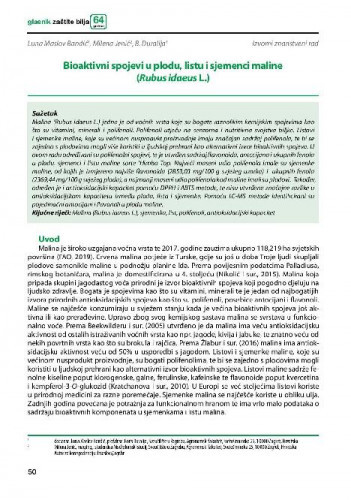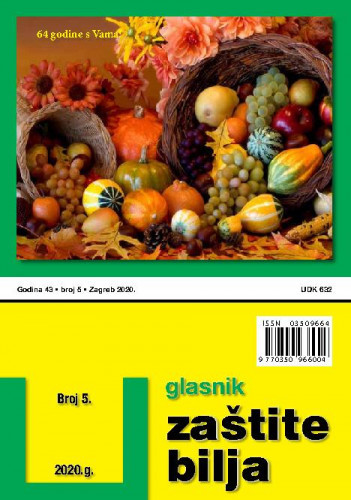Malina (Rubus idaeus L.) jedna je od voćnih vrsta koje su bogate raznolikim kemijskim spojevima kao što su vitamini, minerali i polifenoli. Polifenoli utječu na senzorna i nutritivna svojstva biljke. Listovi i sjemenke maline, koje su većinom nusprodukt proizvodnje imaju značajan sadržaj polifenola, te bi se zajedno s plodovima mogli više koristiti u ljudskoj prehrani kao alternativni izvor bioaktivnih spojeva. U ovom radu određivani su polifenolni spojevi, te je utvrđen sadržaj flavonoida, antocijana i ukupnih fenola u plodu, sjemenci i listu maline sorte 'Himbo Top'. Najveći maseni udio polifenola imale su sjemenke maline, od kojih je izmjereno najviše flavonoida (2853,03 mg/100 g svježeg uzorka) i ukupnih fenola (2369,44 mg/100 g svježeg ploda), a najmanji maseni udio polifenola kod maline imali su plodovi. Također, određen je i antioksidacijski kapacitet pomoću DPPH i ABTS metode, te nisu utvrđene značajne razlike u antioksidacijskom kapacitetu između ploda, lista i sjemenke. Pomoću LC-MS metode identificirani su pojedinačni antocijani i flavonoli u plodu maline.; Raspberry (Rubus idaeus L.) is one of the fruit species that is rich in a variety of chemical compounds such as vitamins, minerals and polyphenols. Polyphenols affect the sensory and nutritional properties of the plant. Raspberry leaves and seeds, which are mostly a by-product of production, have a significant polyphenol content and, together with the fruits, could be used more in the human diet as an alternative source of bioactive compounds. In this work, polyphenolic compounds were determined, and the content of flavonoids, anthocyanins and total phenols in the fruit, seeds and leaves of raspberry cultivar 'Himbo Top' was determined. Raspberry seeds had the highest mass fraction of polyphenols, of which the most flavonoids (2853.03 mg / 100 g of fresh sample) and total phenols (2369.44 mg / 100 g of fresh fruit) were measured, and the lowest mass fraction of polyphenols in raspberries had fruits. Also, antioxidant capacity was determined using DPPH and ABTS methods, and no significant differences in antioxidant capacity were found between fruit, leaves and seeds. Using the LC-MS method, individual anthocyanins and flavonols in raspberry fruit were identified.
Sažetak

 Glasnik zaštite bilja : 43,5(2020) / glavni urednik Katarina Lučić.
Glasnik zaštite bilja : 43,5(2020) / glavni urednik Katarina Lučić.